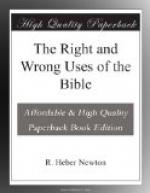1. We have here the simple, homely, prudential aspects of virtue, which have always been particularly powerful on certain ages and classes.
The maxims of a Poor Richard are anticipated here, as quaint, as terse, and as sagacious in the ancient Jew as in the modern American. Our scientific teachers would replace eloquent declamation concerning vices, such as drunkenness and debauchery, by illustrated lectures upon the physiological effects of violations of nature’s laws. They would teach men that the laws of health are found in the laws of temperance and purity. The Hebrew sages had this vision of Wisdom. Their proverbial sayings abound with graphic pen-pictures of the folly of vice. No illustration of the physical consequences of debauchery could be more impressive than the vivid sketch of the foolish young man, going after the strange woman as an “ox goeth to the slaughter,” knowing not that
Her house is the way to hell,
Going down to the chambers
of death.
The favorite name for sin in these proverbs is Folly. Wisdom crieth to the sons of men, in that noblest writing of the sages:
Blessed is the man that heareth
me,
Watching daily at my gates,
Waiting at the posts of my
doors.
For whoso findeth me findeth
life,
And shall obtain favor of
the Lord.
But he that sinneth against
me wrongeth his own soul.
All they that hate me love
death.
2. These laws of life that work for our health and wealth loom, however, into mystic and sacred forms, as of the laws heavenly and eternal, whose “seat is the bosom of God."
When Crito urges his beloved master to escape from the death that had been unjustly decreed for him, Socrates replies in a noble personification of the Laws, as rebuking him for the thought of such an attempt to evade them; and he must be dim-sighted, indeed, who does not see in the forms of the State Laws, the shadows of the Eternal Laws, august and awful, whose constraint was round about his will. That is the vision which we catch through every form of law, sanitary, social, or ecclesiastical, in the Bible. In the earliest code of the Hebrew statutes known to us, a collection of tribal “Judgments” or “dooms,” this high and mystic sense of obligation steals over us. Amid the quaint enactments recorded in the Book of Covenants, whose language carries us back to times of extreme simplicity, we hear the words
Ye shall be holy men unto me.[59]
Our new critics may tell you that the late poet, who wrote that long-drawn sigh of desire for the Law which is bodied in the One hundred and nineteenth Psalm, was thinking of the “Thorah”—the ritual law of the temple and the counsels of the priests. They are doubtless right, if so be that they do not lead you to infer that this devout soul was thinking only of the ecclesiastical law. Through it, there was rising upon his spirit the vision of the Law Eternal and Heavenly, the norm and pattern of the law that on earth binds men to purity and righteousness.




